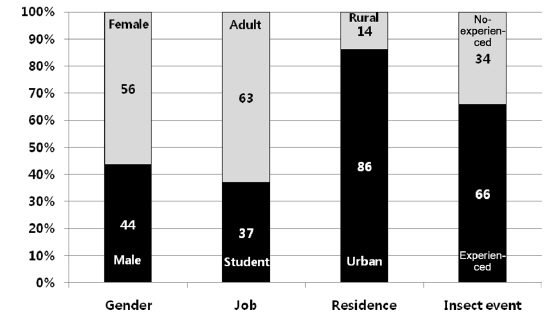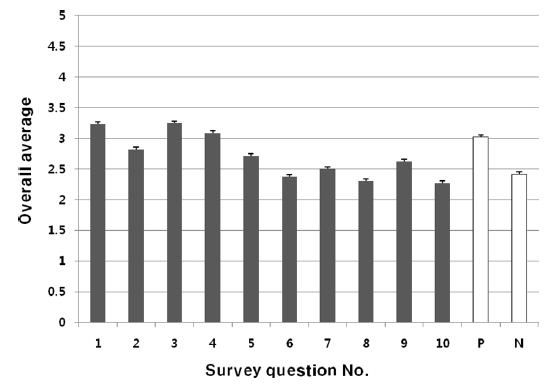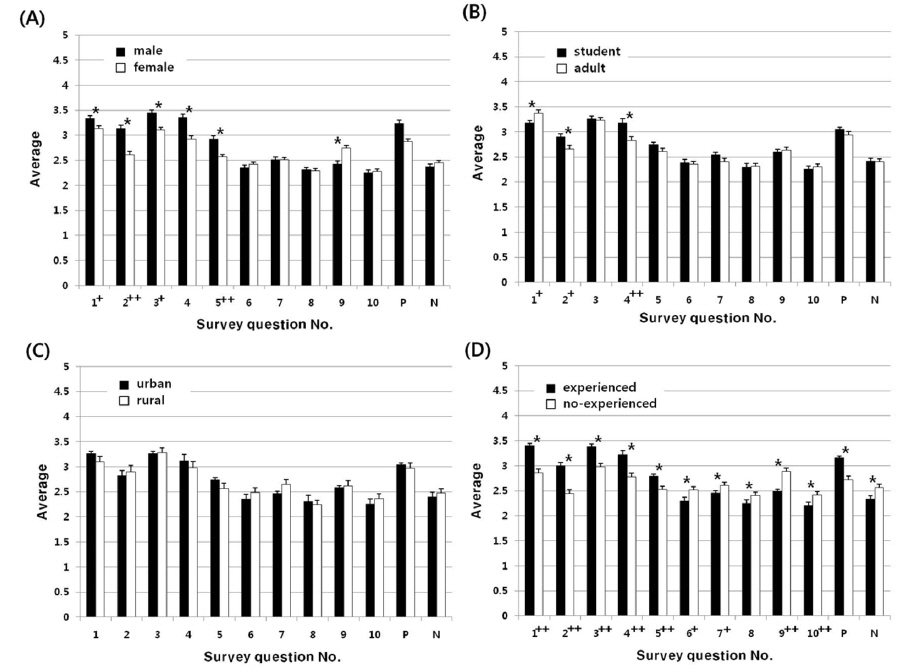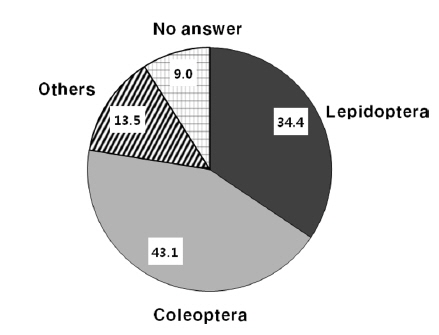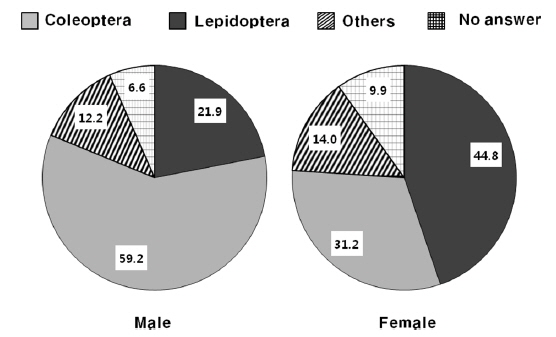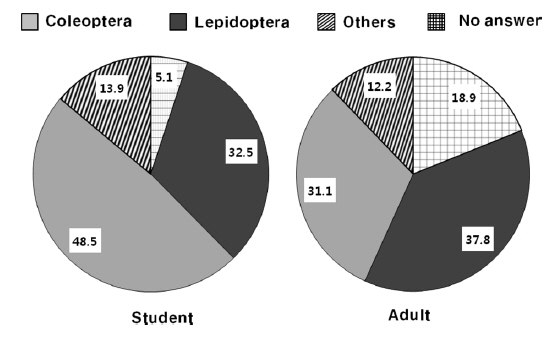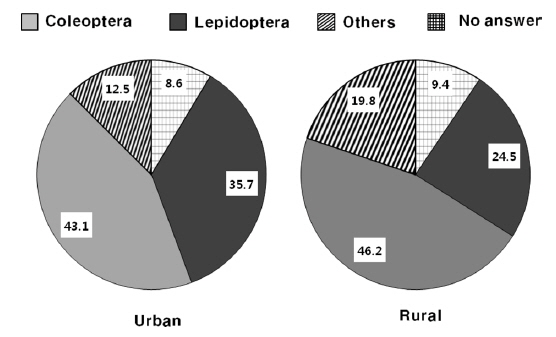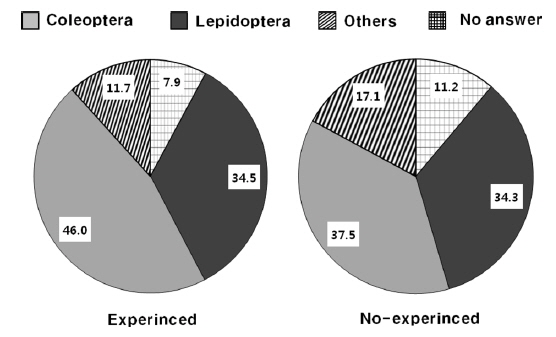



Insects are among the most diverse groups of animals on the planet, representing more than half of all known living organisms (Chapman, 2006). The number of extant species is estimated at between six and ten million, and potentially represents over 90% of the animal life forms on Earth (Chapman, 2006; Vojtech
Worldwide interest in keeping insects as pets is increasing. In Japan, insects are often kept as household pets, as commonly as dogs and cats are. There are several advantages of keeping insects as pets. They are not difficult to find, do not require significant care except for feeding, and can be kept in relatively small spaces. In Korea, although several pet insects have become commercialized, the majority are limited to subfamily Dynastinae and family Lucanidae. Some individuals try to use butterflies and crickets as pet insects as well.
Mental health is a great concern to people in modern times. Mental health includes subjective well-being, perceived selfefficacy, autonomy, competence, intergenerational dependence, and self-actualization of one's intellectual and emotional potential (WHO, 2001). Maintaining good mental health is crucial to living a long and healthy life; this has become increasingly clear in recent years (Patel and Prince, 2010). Various therapies have been developed to prevent mental health problems, including music therapy, art therapy, play therapy, drama therapy, horticultural therapy, and animal-assisted therapy (Kitchener and Jorm, 2002; Marcus, 2013; Söderback
Because the rearing or observation of insects can provide some humans with positive emotions or even affection toward the insects, keeping of insects may be used as an effective therapeutic tool. In this study, we performed a survey examining Korean subjects' likability of insects. These findings may be helpful in developing a therapeutic mental health-care approach that utilizes insects.
The survey was administered to 788 people, including elementary, middle, high school students and adults, from May to October 2013. The survey included ten questions with five positive and five negative responses to insects (Table 1). To study individuals' preferences of insects, the survey included the following insect categories: lepidopteran insects (yellow swallowtail, Chinese peacock, silver-studded blue, hawk moth, common cabbage butterfly, fall webworm, beet armyworm, silkworm, oriental tobacco budworm, and diamondback moth), coleopteran insects (stag beetle, dynastid beetle, Chinese tiger beetle, mealworm beetle, Cetoniidae, firefly, ladybug, long-horned beetle, diving beetle, and jewel beetle), and other insects (dragonfly, cockroach, praying mantis, ant, cricket, grasshopper, stinkbug, cicada, bumble bee, and aphid). The survey results were classified into several groups according to participants' gender, age, residence, and previous experience in insect-related events.
[Table 1.] Questions for the common likability of insects
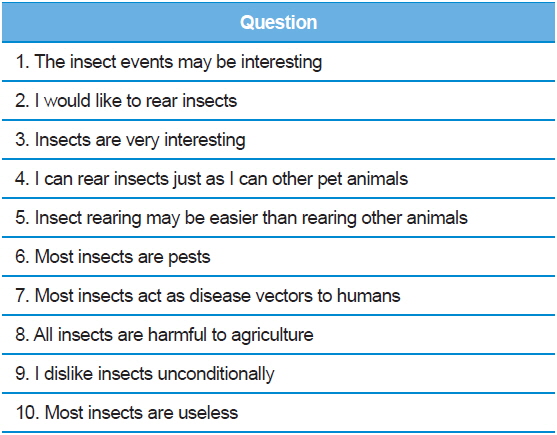
Questions for the common likability of insects
The collected data were converted for coding and analysis using SPSS statistical software (Statistical Product and Service Solutions). The survey responses regarding insect likability were rated on a five-point scale that ranged from "highly positive" to "highly negative." For statistical analysis, these answers were converted to an ordinal scale: highly positive (5), positive (4), normal (3), negative (2), and highly negative (1). Frequency, significant difference, and correlation analyses were performed on the coding data using SPSS program version 12.0 (SPSS, Inc., Chicago, IL, USA). Significant differences in the nominal and ordinal scales were evaluated using cross-tabulation and t-test analysis, respectively.
>
Demographic data and likability for insects
The survey population comprised 788 people, as indicated in Fig. 1. To investigate individuals' likability of insects, the survey included five positive questions about insects (questions numbered 1 to 5) and five negative questions about insects (questions numbered 6 to 10) (Table 1). The survey responses were rated on a five-point scale that ranged from "highly positive" to "highly negative." The overall positive response about insects was higher (with an average of 3.01) than the overall negative response (with an average of 2.4) (Fig. 2). This result suggested that, in general, people have positive feelings about insects. Responses to questions 2 and 5, which inquired about the rearing of insects, yielded a relatively lower score than scores for the other "positive" questions. These data suggest that people do not consider insects as pets in the same way that they consider dogs or cats as pets. The highest-scored item among the "negative" questions was the query about unconditional dislike of insects (question 9). This result corresponds to a previous finding that people tend to dislike insects without clear reasons (Bae
>
Analysis on preference of insects
A survey was conducted to investigate subjects' preferences of particular types of insects: lepidopteran, coleopteran, and other insects. Subjects were asked, "What kind of insect do you like?" The highest preference was for coleopteran insects (43.1%); lepidopteran insects followed with 34.4% (Fig. 4). However, this preference was strongly determined by subjects’ gender, in that 59.2% of males preferred coleopteran insects, while 44.8% of females preferred lepidopteran insects (Fig. 5). Among the specific kinds of insects, stag beetle, dynastid beetle, firefly, yellow swallowtail, and Chinese peacock were more preferable to people (data not shown). This result may be because of the high familiarity of people with these insects through commercialized products and frequent observations. This result also suggests that frequent direct or indirect contact with insects is important in increasing the overall likability of insects. No significant differences or correlations were found for insect preferences between students and adults, urban and rural residents, or between people experienced in insect-related events and those who were not (Figs. 6, 7, 8). Although the common likability of insects varied by job and experience of insect-related events, the preference of insects was not influenced by them. However, gender influenced both the likability and preference of insects. These findings suggest that gender is the most important factor to consider in selecting insects to be used as a therapeutic tool in mental health care.

